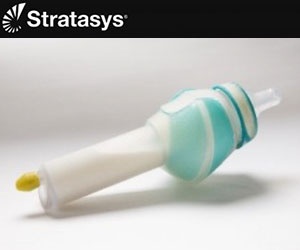Ravid Koriat, a recent graduate of the Bezalel Academy of Arts and Design in Jerusalem, used personal inspiration for her final project in Industrial Design. A conversation with her sister-in-law about the challenges of nursing and pumping “mother’s milk” prompted Koriat to design a new style of feeding system, the FEEDER, specifically for newborns in the neonatal intensive care unit (NICU). To improve the system for breast milk collection, storage and delivery, Koriat developed accurate prototypes using Stratasys’ PolyJet multi-material 3D printing technology.

The Stratasys 3D printed components of Koriat’s FEEDER system, appropriate for premature or ill babies who are fed via tube, syringe or bottle.
Adapting to the NICU Experience
Originally planning a career in fashion design, Koriat decided instead to study industrial design – “designing products that are meant to meet actual needs,” she told the Stratasys Blog in an interview. In the research phase of this project, she spoke with NICU parents, nurses and managers at several Israeli hospitals, including Ichilov, regarded as one of top NICUs in the country. “The NICU is very advanced technologically, and sterility is critical,” she explained in her project case study, “but I have found that there are lots of things that need to be re-designed.”
Premature or ill babies may not be able to nurse like healthy, full-term newborns, but they can absolutely benefit from breast milk. Koriat’s FEEDER design is appropriate for babies who receive their nutrition via bottle, syringe or tube. Because it can be adapted to multiple feeding methods, the pumped milk does not have to be transferred, which exposes it to germs and may cause a loss of quality and quantity. Markings on the side “enables the accurate measurement of the amount of milk given,” a concern for preemie caregivers, she noted.
The Perfect Combination of Rigid, Flexible and Transparent Materials to Evaluate the Final Product

The assembled FEEDER, which combines parts 3D printed in a combination of multiple colors and materials on the Stratasys Objet Connex 3D Printer.
“I needed a lab and a technology that would allow me to 3D print a combination of all the materials in the same prototype. I wanted the resulting model to simulate not only my vision for the product (closest to the SolidWorks design in terms of appearance), but will also provide the right feeling while holding it,” explained Koriat.
An experienced user of SolidWorks, Koriat used the software to bring her product vision to life. After revisions and further discussion with NICU nurses and parents, she 3D printed the FEEDER on the recommendation of one of her instructors at Bezalel. Using an Objet Connex Multi-material 3D Printer allowed for the incorporation of both rigid and flexible materials in her design. Among the materials she used were transparent (VeroClear), rubber-like (TangoPlus), and combination of Rigid Opaque colors (VeroCyan and VeroYellow).
Koriat explained her design decisions and material choices in the case study: “I decided to make the final product out of two different materials – one is rigid and transparent, and the other is a colorful photopolymer.” The FEEDER’s main compartment was 3D printed in VeroClear, taking advantage of the material’s transparency to be able to see the liquid (in this case, milk) level in the bottle. “The colorful pieces will be used for a comfortable grip on the places where the parent is holding the vessel while feeding the baby.”
Ready for Hospital Trials
Koriat emphasized that she is proud of this design and would like to see it being used. It dovetails with equipment that already exists in hospitals. It is not “futuristic or unrealistic,” she told the Stratasys Blog. “From the very beginning of this project it was clear that I wanted to design a realistic product in order to ease its entry to the NICUs. My product is a life-saving concept, and I really want to see it in use as soon as possible.”








Leave A Comment